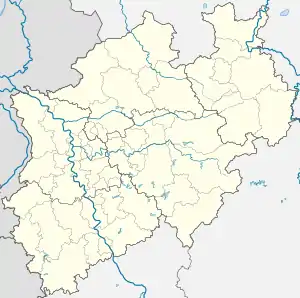Herzogenrath
Herzogenrath (Ripuarian: Herzeroa; Limburgish: Hertseraoj; Dutch: ’s-Hertogenrade)[3] is a municipality in the district of Aachen in the German state of North Rhine-Westphalia. It borders the Dutch town of Kerkrade, the national border in one section running along the middle of a main road[4] and even directly through the centre of the cross-border Eurode office complex.[5]
Herzogenrath | |
|---|---|
 | |
 Flag  Coat of arms | |
Location of Herzogenrath within Aachen district .svg.png.webp) | |
 Herzogenrath  Herzogenrath | |
| Coordinates: 50°52′N 6°06′E | |
| Country | Germany |
| State | North Rhine-Westphalia |
| Admin. region | Köln |
| District | Aachen |
| Subdivisions | 3 |
| Government | |
| • Mayor (2020–25) | Benjamin Fadavian[1] (SPD) |
| Area | |
| • Total | 33.401 km2 (12.896 sq mi) |
| Elevation | 140 m (460 ft) |
| Population (2021-12-31)[2] | |
| • Total | 46,290 |
| • Density | 1,400/km2 (3,600/sq mi) |
| Time zone | UTC+01:00 (CET) |
| • Summer (DST) | UTC+02:00 (CEST) |
| Postal codes | 52134 |
| Dialling codes | 02406 and 02407 |
| Vehicle registration | AC |
| Website | www.herzogenrath.de |
History
Herzogenrath began in the 11th century as a settlement called Rode near the river Wurm. In 1104, Augustinian monks founded an abbey, called Kloosterrade, to the west of this settlement.
It became 's-Hertogenrode or 's-Hertogenrade (Dutch: the Duke's Rode) after the Duchy of Brabant took control of the region; in French it was called Rolduc (Rode-le-Duc).
.jpg.webp)
As is the case for many parts of Duchy of Brabant, Herzogenrath changed hands several times in the last few centuries. Together with the rest of the Southern Netherlands, it was under Spanish control from 1661, Austrian between 1713 and 1795 and French between 1795 and 1813. In 1815, when the Kingdom of the Netherlands was formed under the terms of the Vienna Congress, the border was drawn through the town, the eastern part being Prussian Herzogenrath and the western part Dutch Kerkrade.[6] The former abbey is now the Rolduc Congress Center in Kerkrade.
During World War I, the Germans erected a fortification along the border street for the first time; although it was dismantled at the end of the war, it was reconstructed again at the beginning of World War II.[6] Following the end of that war, the border fortifications were reduced at various times, although they were not fully dismantled until the early 1990s preparations for the Schengen Area.[6]
The two towns now share some of their public services,[7] and promote themselves as a binational "City of Eurode" for economic development purposes.[6]
Culture
In addition to Standard German, many inhabitants of Herzogenrath speak the Kerkrade dialect, a Ripuarian variety also spoken on the other side of the border in Kerkrade.[8]
Economy
Until the 1950s, Herzogenrath's economy was dominated by coal mines and a nearby coking plant. While some remains of the mining industry still form parts of the landscape in the form of overgrown slag heaps, today's Herzogenrath has moved into other industries. Large-scale employers include Saint-Gobain, Aixtron, Vetrotex (textile glass) and Ericsson Eurolab (electronics). The city hosts a number of electronics start-ups, profiting from the neighbouring Technical University RWTH Aachen.
Gallery
 Rode Castle
Rode Castle Church of Saint Gertrude of Nivelles
Church of Saint Gertrude of Nivelles Church tower of the Church of Saint Gertrude of Nivelles
Church tower of the Church of Saint Gertrude of Nivelles Ferdinand Schmetz Square
Ferdinand Schmetz Square
References
- Wahlergebnisse in NRW Kommunalwahlen 2020, Land Nordrhein-Westfalen, accessed 19 June 2021.
- "Bevölkerung der Gemeinden Nordrhein-Westfalens am 31. Dezember 2021" (in German). Landesbetrieb Information und Technik NRW. Retrieved 20 June 2022.
-
- German pronunciation of Herzogenrath: [ˌhɛʁtsoːɡn̩ˈʁaːt] ⓘ.
- Ripuarian pronunciation of Herzeroa: [ˈɦæχtsəʁoə]. In the Netherlands, the name is spelled Hertseroa.
- Limburgish pronunciation of Hertseraoj: [ˈɦæʀtsəʀɔːj].
- Dutch pronunciation of Herzogenrath: [ˌɦɛrtsoːɡə(n)ˈraːt]; local (Kerkrade) pronunciation: [ˌɦæχtsoːɡənˈʁaːt].
- Dutch pronunciation of ’s-Hertogenrade: [ˌsɛrtoːɣə(n)ˈraːdə]; local: [ˌsæχtoːʁə(n)ˈʁaːdə].
- "Kerkrade (NL) - Herzogenrath/Kohlscheid (DE)". grenzen.150m.com. Archived from the original on 10 October 2014. Retrieved 7 September 2014.
- "Neue Anlaufstelle für Grenzpendler in der Euregio". Aachener Zeitung, September 6, 2016.
- Jan Buursink and Nicole Ehlers, "The Binational City of Eurode" Archived 2020-11-24 at the Wayback Machine. University of Nijmegen.
- "World's Most Unique Cities". Toronto Star, June 2, 2016.
- "Eurode - Auf dem Weg zur ersten europäischen Stadt - | Stadt Herzogenrath" (in German). Retrieved 12 July 2023.
- "Städtepartnerschaft, Städtefreundschaft". herzogenrath.de (in German). Herzogenrath. Retrieved 2021-02-15.
External links
 Media related to Herzogenrath at Wikimedia Commons
Media related to Herzogenrath at Wikimedia Commons- Official website
 (in German)
(in German)